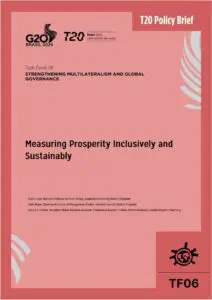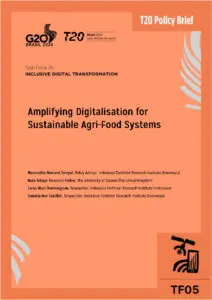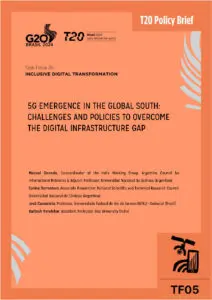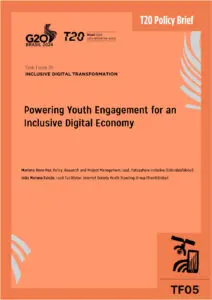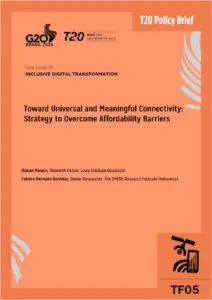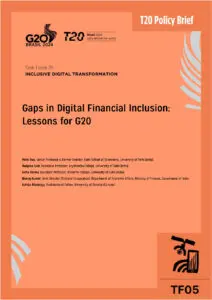The COVID-19 pandemic has highlighted long-standing fractures in the international financial system, especially weaknesses in the safety net for emerging market and developing economies (EMDEs). We present a proposal to provide short-term liquidity to EMDEs that face balance of payment stresses due to global shocks. Our proposal for a liquidity insurance mechanism would, in effect, institutionalize the ad hoc swap lines provided by the central banks of the major countries, providing and broadening access to short-term lines of credits to EMDEs. The structure of the mechanism would involve insurance premiums based on publicly observed macroeconomic variables, rather than the ex-ante or ex-post conditionality associated with programs currently offered by the International Monetary Fund (IMF), thereby eliminating the stigma that seeking insurance might signal a country’s weakness. Such a mechanism would alleviate pressures on IMF resources and allow the institution to focus on its core mission of conducting surveillance and fixing the policies of countries that have deeper solvency problems.
Challenge
The economic effects of the COVID-19 pandemic around the world have highlighted the need for a better global financial safety net that provides more systematic protection for EMDEs. These countries, which face significant economic pressures even in normal times, have little room to maneuver when faced with such global shocks. Given their rising importance in the world economy, helping these countries better withstand global shocks is also in the interest of the advanced economies.
Many EMDEs were solvent during the pandemic but faced severe foreign liquidity issues as revenues from tourism and exports of goods and services dried up. Adding to these pressures, at the onset of the pandemic, EMDEs faced sudden stops in capital inflows and downward pressures on their exchange rates. Even for those countries with relatively sound macroeconomic fundamentals, financing conditions tightened as spreads on their sovereign bonds widened, in sharp contrast to the decline in government bond yields in advanced economies. Subsequently, some EMDEs faced resurgent capital inflows due to the global low interest rate environment and weakening of the dollar. While this provided temporary relief, such cycles of capital flow stalls and surges complicate macroeconomic management in these countries.
EMDEs will remain subject to capital flow and exchange rate volatility as major advanced economies rely on monetary policy measures, both conventional and unconventional, for economic support, and the spillover effects of these policies could cause whiplash effects. Reliance on foreign liquidity funding, notably in U.S. dollars, remains a source of vulnerability for many EMDEs.
The universal need for foreign liquidity during periods of global shocks has motivated the advanced economies to establish bilateral swap lines among their central banks. These arrangements, which have become common among central banks of advanced economies since the global financial crisis, including during the COVID-19 recession, are not available to most EMDEs to help alleviate their foreign exchange liquidity shortages. Only a handful of EMDEs and small advanced economies had access to such swap lines from the Fed, for instance. At the height of the pandemic, the Fed did offer dollar funding lines to a larger group of such countries, collateralized by their central banks’ holdings of U.S. Treasury securities. However, such ad hoc measures fall short of a more structured approach. An institutionalized mechanism for emergency liquidity assistance would be more effective. It would reduce the incentive for EMDEs to undertake self-insurance through reserve accumulation, which is inefficient at both the national and global levels. It would also alleviate pressure on IMF resources and allow the institution to focus on its core mission of solvency issues.
The current global financial architecture lacks a robust systematic mechanism to provide foreign exchange liquidity to EMDEs. The IMF has various programs to offer lines of credit but with ex-ante conditionality, such as the Flexible Credit Line and the Precautionary Lending Line. The take-up has been very limited, perhaps because of the stigma effect. Countries might be reluctant to apply for such programs if they are concerned about market implications should they fail to qualify.1 Also, losing eligibility for the program after one or more years of successful qualification could also bring heightened market pressures on their economies and currencies. Thus, a better system for global provision of adequate emergency, shortterm liquidity is needed. The IMF’s SDRs do provide a line of credit with no conditionality attached but they are limited in scope-the SDR allocations of EMDEs are trivial relative to their balance of payments needs. In what follows, we elaborate on the design features of this mechanism and address some practical considerations related to implementation.
Proposal
GLOBAL LIQUIDITY INSURANCE MECHANISM
A solution to the systematic provision of foreign exchange liquidity during periods of crises is an insurance pool for the world’s major economies-mainly but not necessarily just for the EMDEs. 2 The design features of the Global Liquidity Insurance Mechanism (GLIM) would be as follows. Each country would pay a modest entry fee, between US$1 billion and US$10 billion, depending on the size of its economy as measured by GDP, to provide an initial capital base. 3 The country would then pay an annual premium for insurance that it could call upon in the event of a crisis. The premium would depend on the level of insurance desired and could on average be about 3% of the face value of the insurance policy (e.g., US$3 billion in annual premiums for US$100 billion of insurance). This premium level is roughly the same order of magnitude as the current quasi-fiscal cost of reserve accumulation through sterilized intervention, so the premium would be calibrated to cost no more than the implicit cost of self-insurance.
The initial contribution and the annual premiums would be invested in a portfolio consisting of government bonds of the major countries in the Special Drawing Rights (SDRs) basket, (i.e., United States, Euro zone, United Kingdom, Japan, and China) in proportion to their importance in international trade and finance. In return for this financing for some of their debt, the central banks of these countries would be obliged to backstop, as needed, the pool’s lines of credit in the event of a global crisis. This would simply institutionalize such ex-ante swap arrangements that the G-3 central banks opened up during the crisis to provide liquidity to other central banks. The pool can also be backstopped by SDRs if the G20 commits ex-ante to authorize the IMF to leverage unused SDRs or create new ones in the event of a systemic global shock. In other words, the IMF could serve as an additional guarantor for a portion of the credit lines in the event of a catastrophic global shock. This could be useful early in the operation of the insurance pool before it has built up substantial reserves.
The insurance payout would be in the form of a credit line open for a short period, e.g. one year, rather than an outright grant. The interest rate would be non-punitive and based on the yields on short-term government securities in the countries backing up the insurance pool. The country drawing on this insurance would be required to pay back the borrowed amount within the one-year period in the same hard currency of the original loan. If a country’s currency depreciated in the ensuing year, it would have a higher debt burden in domestic currency terms. This mitigates moral hazard that could ensue from any incentive the country’s policymakers have to undertake undisciplined policies under the protection provided by the credit line. The country would not be able to buy additional insurance until there was a full repayment of the initial draw from the insurance pool. Premiums would be raised substantially if a country wished to renew its insurance in the next period after drawing on the credit line without any measurable improvements in its policies.
Thus, the insurance would only be suitable for liquidity crises. For an economy beset by a solvency crisis, the insurance payout would effectively buy a limited amount of breathing space. Once the credit line lapses and if the country proves to have a solvency rather than liquidity problem (which may be difficult to determine ex-ante), then the premiums would rise to punitive levels. In that case, the country would have to go to the IMF for traditional borrowing with ex-post conditionality, with any funds drawn through the GLIM (and not yet paid back) becoming folded into such an arrangement.
The mechanism outlined above is different from traditional insurance where the idea is to pool risks. In this case, the main risk may be global rather than country specific. This also makes it hard to price the premiums in an actuarially “fair” way as the major risks are by definition correlated across countries if the underlying shock is global. This mechanism is simple and could easily be managed by an institution such as the Bank for International Settlements (BIS). Since the BIS itself does not monitor countries’ policies, it could run the mechanism as a neutral party.
The crux of the proposal is that it broadens and depoliticizes access to foreign liquidity, either from the major advanced economy central banks or through SDR allocations, in the event of a major global shock. It would free up the IMF to do what it does best-conduct surveillance and fix the policies of countries with deeper solvency problems in terms of domestic or external debt.
PARTICIPATION
Broad participation by the large economies, such as those in the G-20, would be important for obviating the stigma that the very act of seeking insurance might signal a country’s weakness. Unlike in health insurance, where broadening the pool by mandating universal participation reduces premiums and adverse selection, the broad mandate here would mainly be to deal with the stigma effect.
One solution could be to make participation in this pool a condition for continued membership in a body such as the Financial Stability Board (FSB), where all countries would like to have a seat as it will have an important role in developing principles for international financial regulation (participation in the insurance pool would, however, not be a guarantee of membership in the FSB). This would address the stigma issue as well as connect financial policies to macroeconomic policies, as their interaction is clearly crucial for global economic outcomes. No country would be forced to buy insurance but would have to pay the basic membership fee to be part of the pool.
SOME PRACTICAL CONSIDERATIONS
The implementation of the proposed insurance mechanism raises at least two issues. First, whether it is politically feasible for a national government to pay premiums for such insurance and, second, whether the insurance could encourage unreasonable risk taking.
On political feasibility, given that the GLIM option would be cheaper (or at least not more expensive) than the quasi-fiscal costs of sterilizing reserves that are built up for insurance purposes, not involve currency risk, and requires a relatively modest premium, it should not be difficult for a government to make a strong case to its constituents for participation in GLIM.4 For some emerging markets, it would be seen as a small price to pay for avoiding IMF loans with attached conditionality. Similarly, moral hazard is less likely to be a problem because national policies and their outcomes are publicly observable. This makes it unlikely that balance of payments protection provided by the insurance scheme would encourage undisciplined policies. A related problem is that investors might be more willing to lend money to participating countries in the GLIM because their debts are seen as repayable. This could also encourage fiscal profligacy. Rising insurance premiums as debt levels increase would help mitigate this problem.
STRENGTHEN GLOBAL FINANCIAL STABILITY
The design features of the GLIM can be enhanced to strengthen further global financial stability in addition to institutionalizing and broadening access to foreign exchange liquidity.
First, the level of the premium in a particular year could depend not only on the level of insurance desired but also the quality of a country’s policies. There would be higher premiums for a country that chose to run large budget deficits or that accumulated large amounts of debt, thereby increasing its vulnerability to crises. The principle is analogous to car insurance, where owners of more expensive cars and riskier drivers (based on verifiable characteristics like age and gender) face higher premiums. There would be discounts from the base level for countries that have demonstrated policy discipline.
Second, premiums would have to be based on simple and transparent rules. For instance, a current account deficit larger than 2% of a country’s GDP triggers a higher premium. Other criteria that affect premiums could be based on variables such as budget deficits, public debt, and external debt (all relative to GDP). In the interest of simplicity and tractability, there would be no country-specific adjustments such as adjusting the budget deficit for business cycle conditions, which would be contentious and also difficult to deal with in real time. The premiums would increase in a nonlinear fashion with the persistence and levels of policies that contributed to an economy’s vulnerability. A country running large budget deficits or continuing to accumulate large stocks of external debt in successive years would pay rising premiums in each of those years. In this way, the country’s contributions to rising global risks would be accounted for. The scheme would be a transparent rules-based mechanism to strengthen the power of moral suasion to get a country to at least partially internalize the effects of its own policies on global risks. There is no specific stigma or signaling effect associated with the premium levels as they are based on country variables that are all public knowledge.
To avoid concerns about procyclicality of premiums a country having to face higher payment amounts at a time of heightened need for foreign currency liquidity, which is precisely when its macroeconomic situation might worsen the premiums could be based on oneyear lagged values of the variables that enter the premium calculations.
Finally, the existence of such an insurance scheme would also help separate out the motives mercantilist versus precautionary behind foreign exchange intervention and related reserve accumulation. The costs of reserve accumulation are seen by some emerging market policymakers as being balanced by the joint benefits of insurance and maintaining trade competitiveness. By providing an alternative (and cheaper) option for insurance, the mechanism we propose would force emerging market economies to more directly consider the costs of protecting trade competitiveness through intervention in currency markets.
POLICY RECOMMENDATION
Strengthen the international financial safety net by instituting a mechanism for providing short-term liquidity to EMDEs that face balance of payment stresses due to global shocks. A global liquidity insurance mechanism (GLIM) would, in effect, institutionalize the swap lines currently provided on a bilateral, selective, and ad hoc basis by the central banks of the major reserve currency economies and expand access to a broader group of EMDEs. The mechanism would obviate stigma and other barriers to participation by conditioning insurance premiums on publicly observed macroeconomic variables, rather than the ex-ante or ex-post conditionality associated with programs currently offered by the IMF. This would reduce the incentives for EMDEs to self-insure through costly and inefficient reserve accumulation, alleviate pressures on IMF resources, and promote global financial stability.
NOTES
1 See https://www.imf.org/external/np/pp/eng/2014/012714a.pdf, January 2014.
2 The insurance scheme proposed here is not relevant for the major reserve currency economies, which are covered by institutionalized bilateral swap lines that can cover their foreign currency liquidity needs.
3 If this scheme was later extended to cover smaller and less developed economies, the entry fee could be reduced or even waived as the insurance pool would presumably have built up reserves by that time.
4 Countries with weak policies would be charged higher-than-average premiums. This would match their correspondingly higher costs of self-insurance through reserve accumulation; their sterilized intervention costs would be higher than average as they would typically face wider spreads on government (or central bank) bonds relative to the interest earned on reserves.
REFERENCES
Coulibaly, B. and E. Prasad, “The International Monetary and Financial System: How to fit it for purpose?”, in Reimagining the Global economy: Building back better in a post-COVID-19 world, Brookings Institution, 2020
Prasad, E., The Dollar Trap: How the U.S. Dollar Tightened Its Grip on Global Finance, Princeton, NJ, Princeton University Press,2014



